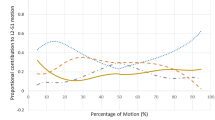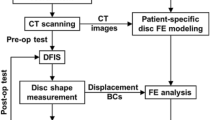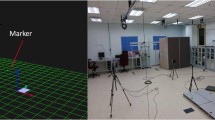Abstract
Effects of disc degeneration (DD) on mobility under loads have been demonstrated, but they are not taken into account when providing experimental corridors for ranges of motion (ROM); this could explain that these corridors are usually very large. Other influencing factors such as lumbar level or geometry have seldom been studied, and never conjointly. The objectives of the study were to understand relationships between intervertebral discs (IVDs) mobility disparity and disc characteristics using medical imaging. For that purpose, an in vitro biomechanical and imaging protocol was conducted on human lumbar IVDs: 22 specimens (14 L1-L2 and eight L4-L5) were considered. Radiography, MRI, discography and macroscopic slices were obtained. Flexion/extension, lateral bending and torsion 10 Nm moments were applied on each specimen, with and without posterior elements. 3D motion of the upper vertebra was recorded. After testing, morphometric data was measured, DD was assessed and pathological singularities were identified. Mobility corridors for each spinal level in all loading modes were very large. For example, lateral bending ROMs within L1-L2 group ranged from 0.5° to 10.5°. Abnormal behaviours such as excessive ROMs or extension greater than flexion were listed. In most cases, imaging could identify the reasons of these erratic behaviours (scoliosis, calcification, retrolisthesis, etc.). After discarding six discs carrying major anomalies identified by imagery, mobility corridors were drastically reduced (min 3°, max 6.5° for the same L1-L2 lateral bending example). In specimens without abnormalities, relationship between geometry and ROMs could be revealed. As a conclusion, this study provided more relevant data for ROM of lumbar spine functional units. For the first time relationships could be considered between image attributes and mechanical properties.
Résumé
Les effets de la dégénérescence discale sur la mobilité rachidienne ont été démontrés; ceux-ci ne sont pourtant pas considérés dans les corridors expérimentaux de la littérature rapportant des amplitudes de mobilité. Ceci constitue la raison probable pour laquelle ces corridors sont souvent très grands. D’autre facteurs d’influences, tels que le niveau lombaire ou la géométrie, ont rarement été étudiés et jamais conjointement. Les objectifs de cette étude étaient de comprendre les relations existant entre les disparités de mobilité du disque intervertébral et les caractéristiques discales associées, en utilisant l’imagerie médicale. A cette fin, un protocole expérimental in vitro (biomécanique et imagerie) a été conduit sur des disques intervertébraux lombaires humains : 22 spécimens (14 L1-L2 and 8 L4-L5) ont été considérés. Radiographies, IRM, discographies et coupes macroscopiques ont été obtenues. Des moments de flexion/extension, inflexion latérale et torsion (max 10 Nm) ont été appliqués sur chaque spécimen, avec et sans arcs postérieurs; le mouvement 3D de la vertèbre supérieure a été enregistré. Après ces tests, des données morphométriques ont été mesurées, l’état de dégénérescence discale a été évalué et les singularités pathologiques ont été identifiées. Les corridors de mobilité pour chaque niveau lombaire étaient très grands dans toutes les directions de chargement. Par exemple, les amplitudes en inflexion latérale au sein du groupe L1-L2 s’échelonnaient de 0.5 à 10.5 degrés. Les comportements anormaux, comme des amplitudes excessives ou une extension supérieure à la flexion, ont été répertoriés. Dans la plupart des cas, l’imagerie a pu identifier les raisons de ces comportements erratiques (scoliose, calcifications, rétrolisthésis, etc.). En retranchant à l’échantillon 6 disques porteurs d’anomalies majeures décelées par l’imagerie, les corridors de mobilité ont été fortement réduits (min 3, max 6.5 degrés pour le même exemple du groupe L1-L2 en inflexion latérale). Chez les spécimens exempts d’anomalies, des relations entre géométrie et amplitudes de mobilité ont pu être mises en évidence. En conclusion, cette étude a permis de préciser et d’affiner les corridors de mobilité au niveau lombaire. Pour la première fois, des relations ont pu être considérées entre des attributs extraits de l’image et des propriétés mécaniques.





Similar content being viewed by others
Notes
The test device and protocol are labelled by a quality certification NF EN ISO/CEI 17025.
References
Adams MA (1988) The lumbar spine in backward bending. Spine 13:1019–1026
Adams MA (2000) Mechanical initiation of intervertebral disc degeneration. Spine 25:1625–1636
Buckwalter JA (1995) Aging and degeneration of the human intervertebral disc. Spine 20:1307–1314
Coventry MB (1945) The intervertebral disc: its microscopic anatomy and pathology—part I: anatomy, development and physiology. J Bone Joint Surg 27:105–112
Coventry MB (1945) The intervertebral disc: its microscopic anatomy and pathology—part II: changes in the intervertebral disc concomitant with age. J Bone Joint Surg 27:233–247
Farfan HF (1973) Mechanical disorder of the low back. Lea & Febiger, Philadelphia
Fujiwara A (2000) The effect of disc degeneration and facet joint osteoarthritis on the segmental flexibility of the lumbar spine. Spine 25:3036–3044
Gibson MJ (1986) Magnetic resonance imaging and discography in the diagnosis of disc degeneration. A comparative study of 50 discs. J Bone Joint Surg Br 68:369–373
Goel VK (1985) Kinematics of the whole lumbar spine. Effect of discectomy. Spine 10:543–554
Gunzburg R (1992) A cadaveric study comparing discography, magnetic resonance imaging, histology, and mechanical behavior of the human lumbar disc. Spine 17:417–426
Lafage V (2004) 3D finite element simulation of Cotrel-Dubousset correction. Comput Aided Surg 9:1–9
Lavaste F (1990) Protocole expérimental pour la caratérisation de segments rachidiens et de matériels d’ostéosynthès dorso-lombaires. Rachis 2:435–446
Mimura M (1994) Disc degeneration affects the multidirectional flexibility of the lumbar spine. Spine 19:1371–1380
Modic MT (1988) Imaging of degenerative disk disease. Radiology 168:177–186
Nachemson A (1960) Lumbar intradiscal pressure. Experimental studies on post-mortem material. Acta Orthop Scand Suppl 43:1–104
Nachemson AL (1979) Mechanical properties of human lumbar spine motion segments. Influence of age, sex, disc level, and degeneration. Spine 4:1–8
Natarajan RN (1999) The influence of lumbar disc height and cross-sectional area on the mechanical response of the disc to physiologic loading. Spine 24:1873–1881
Oxland TR (1996) The relative importance of vertebral bone density and disc degeneration in spinal flexibility and interbody implant performance. An in vitro study. Spine 21:2558–2569
Panjabi MM (1977) Experimental determination of spinal motion segment behavior. Orthop Clin North Am 8:169–180
Panjabi MM (1994) Mechanical behavior of the human lumbar and lumbosacral spine as shown by three-dimensional load-displacement curves. J Bone Joint Surg Am 76:413–424
Pearce RH (1987) Degeneration and the chemical composition of the human lumbar intervertebral disc. J Orthop Res 5:198–205
Pfirrmann CW (2001) Magnetic resonance classification of lumbar intervertebral disc degeneration. Spine 26:1873–1878
Posner I (1982) A biomechanical analysis of the clinical stability of the lumbar and lumbosacral spine. Spine 7:374–389
Schmidt TA (1998) The stiffness of lumbar spinal motion segments with a high-intensity zone in the anulus fibrosus. Spine 23:2167–2173
Stokes IA (1980) Measurement of movement in painful intervertebral joints. Med Biol Eng Comput 18:694–700
Tanaka N (2001) The relationship between disc degeneration and flexibility of the lumbar spine. Spine J 1:47–56
Tencer AF (1982) Some static mechanical properties of the lumbar intervertebral joint, intact and injured. J Biomech Eng 104:193–201
Twomey L (1985) Age changes in lumbar intervertebral discs. Acta Orthop Scand 56:496–499
Yamamoto I (1989) Three-dimensional movements of the whole lumbar spine and lumbosacral joint. Spine 14:1256–1260
Acknowledgements
The authors thank A. Feydy and the radiologists of the Beaujon Hospital (Paris), the Center of body donation of the Saints-Pères (Paris), J. Magnier, M. Thourot, L. Moraud, and Biospace company. This work was partly founded by Valorisation Recherche Québec, Fondation Canadienne pour l’Innovation and French Fonds de la Recherche Technologique (N 01B0171).
Author information
Authors and Affiliations
Corresponding author
Rights and permissions
About this article
Cite this article
Campana, S., de Guise, J.A., Rillardon, L. et al. Lumbar intervertebral disc mobility: effect of disc degradation and of geometry. Eur J Orthop Surg Traumatol 17, 533–541 (2007). https://doi.org/10.1007/s00590-007-0243-z
Received:
Accepted:
Published:
Issue Date:
DOI: https://doi.org/10.1007/s00590-007-0243-z




